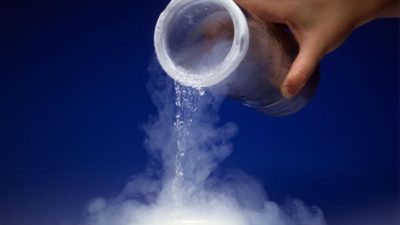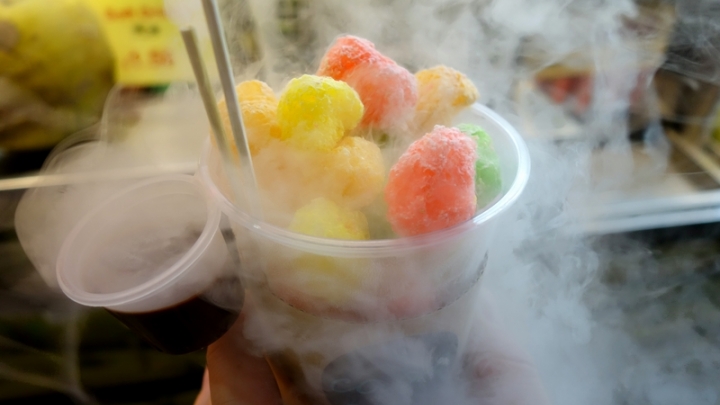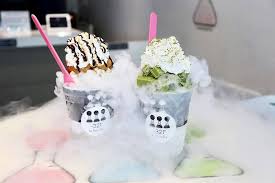She just loves desserts and drinks made with liquid nitrogen! But, last week my babe was feeling a burning sensation in her mouth right after taking nitrogen-made ice cream. It wasn’t that serious but still, we have to go to the hospital.
Is liquid nitrogen edible or not? Yes, it is non-toxic and edible. But, it makes the food extremely cool which can damage the skin and internal organs.
According to the U.S. Food and Drug Administration (FDA), the cold vapor or gas that liquid nitrogen creates can burn the skin tissues. Whereas the vapor can burn the skin of your hand, mouth, or internal organs may face serious damage. Due to such issues, the FDA is warning people to avoid such frozen desserts and drinks.
Want more clarification about, is liquid nitrogen edible? Don’t worry! Scroll down to get more details.
Read also: Is Liquid Nitrogen Ice Cream Edible
Is Liquid Nitrogen Edible Or Not?

Liquid Nitrogen is edible but the extremely cold temperature can cause frostbite and thermal burns.
Taking liquid nitrogen-made desserts and drinks can give a better feel of coldness, and that’s why the dishes are on-trend.
As restaurants or bars use this cryogenic liquid for instant servings, it makes the food extremely cold. Trust me, the actual health risk arises from here!
If you consume these cold desserts or drinks, it can cause frostbite and damage the tissue of the digestive organ permanently. To avoid such health risks, the FDA suggests avoiding eating frozen desserts or drinks made with liquid nitrogen.
Why Does The FDA Warn of Liquid Nitrogen?

As Liquid Nitrogen can damage the skin and internal organs, the FDA is warning us to avoid eating frozen desserts. Even after the liquid nitrogen has fully evaporated, the low temperature of the food can cause damage to internal organs.
Though liquid nitrogen is non-toxic, it can cause a serious risk of breathing problems. In fact, if you have previous asthma records, the inhaling of liquid nitrogen vapor may cause serious problems.
Now, according to the FDA, liquid nitrogen can damage the skin while handling. If the skin comes in contact with the cold vapors and gasses produced by liquid nitrogen, it can cause frostbite and thermal burns.
On top of that, drinks with liquid nitrogen can emit a fog that causes a burning sensation. As a result, this fog can injure the skin and cause severe damage to nerves. To keep you safe from such issues, it is better to avoid drinks and desserts made with liquid nitrogen.
What Happens If I Swallow Liquid Nitrogen?
If you swallow liquid nitrogen, it can damage the skin tissue of the mouth and internal organs.
So, it is better to avoid eating frozen desserts or drinks made with liquid nitrogen. You may think, why should I avoid such dishes where lots of nitrogen-made dishes are on trend!
Let’s clear it up in detail. Liquid nitrogen may fully evaporate but the food remains at a low temperature. As a result, it can cause damage to internal organs. Besides, when the liquid nitrogen evaporates, it releases a large volume of gas. Hence, if you swallow excess liquid nitrogen, it can burst the stomach.
Further, drinks with liquid nitrogen can emit fog. Due to such fog, it can cause a burning sensation and injure the skin. Regular taking of these frozen drinks can cause severe damage to nerves. That’s why the FDA suggests avoiding such frozen foods.
Why Liquid Nitrogen Used On Foods?
Liquid Nitrogen is used on foods to preserve them quickly. As it can freeze anything in an instant, it is widely used on ice cream, desserts, and drinks.
Traditional freezing methods take hours to freeze or chill large quantities of food. For such reasons, this method is not suitable to serve instant food. Besides, traditional methods can’t maintain the freshness that hampers the quality of food.
But, as the liquid nitrogen comes at − 196 °C, it can freeze or chill large amounts of food instantly. As a result, it is ideal to use for instant food servings. Also, taking ice creams and cocktails with liquid nitrogen gives a better feel of coldness.
To make these foods safe, liquid nitrogen must be fully evaporated from the food or drink before serving. Yet, the foods remain extremely cold which can damage the skin tissue of the mouth and internal organs.
Is Liquid Nitrogen Ice Cream Healthy?

Yes, liquid nitrogen ice cream is healthy but comes with little risk.
Ice cream made with liquid nitrogen is much richer than the regular one. In fact, normal ice cream takes hours in cooling which results in lots of air pockets. But, as the liquid nitrogen can freeze ice cream in an instant, it contains fewer air pockets and offers a better taste.
On top of that, ice cream and drinks are ideal for instant servings. Due to the use of liquid nitrogen, ice cream becomes easy to serve instantly. Also, the liquid nitrogen is non-toxic, colorless, and tasteless. So, it won’t affect or hamper the taste of the real flavor.
But, everything comes at a cost. As the liquid nitrogen makes the ice cream extremely cold, it can harm the tissue of digestive organs like the mouth and stomach. Due to such reasons, the FDA suggests you avoid nitrogen ice cream.
Can I touch Liquid Nitrogen?

No, you can’t touch liquid nitrogen as it can cause serious damage to the skin.
Liquid nitrogen comes with − 196 °C that produces cold vapors and gasses. When you’re making or taking a dish with it, you can touch the gas or vapor. If your hand gets in touch with the vapor of liquid nitrogen, it can cause thermal burns or frostbite.
Now, thermal burns can be a serious issue as it results in skin cracking and blood vessels damage. If the situation gets worse, frostbite can even cause permanent tissue damage. So, always wear gloves while working with such cryogenic liquid.
Final thoughts
Finally, we made it to the finish line. As we covered all the information about liquid nitrogen, we hope you understand that it is non-toxic and edible. Besides, we covered some related topics that may help you to keep safe while working with liquid nitrogen.
But, as this liquid makes food extremely cold, swallowing the liquid nitrogen can damage the skin tissue of the mouth and internal organs.
Due to such issues, FDA warns to avoid nitrogen-made food. So, try to avoid foods made with liquid nitrogen to keep yourself safe!